Fishing industry


The fishing industry includes any industry or activity concerned with taking, culturing, processing, preserving, storing, transporting, marketing or selling fish or fish products. It is defined by the Food and Agriculture Organization as including recreational, subsistence and commercial fishing, and the related harvesting, processing, and marketing sectors.[2] The commercial activity is aimed at the delivery of fish and other seafood products for human consumption or as input factors in other industrial processes. Directly or indirectly, the livelihood of over 500 million people in developing countries depends on fisheries and aquaculture.[3]
The fishing industry is notably connected to a number of major environmental issues: including overfishing, . Additionally the combined pressures of forces like climate change, biodiversity loss, and overfishing endanger the livelihoods and food security of substantial portion of the global population. International policy to attempt to address these issues is captured in Sustainable Development Goal 14 "life below water" and subgoal 14.4. "Sustainable fishing".[4]
Sectors[]
| |||||||||||||||||||||||||||||||||||||||||||||||||||||||||||||||
Commercially important finfish fisheries
|


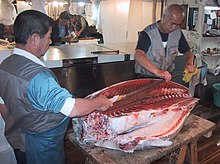
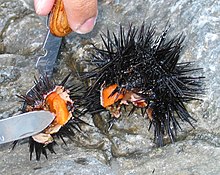

There are three principal industry sectors according to the Food and Agriculture Organization as including recreational, subsistence and commercial fishing.[2]
Other slightly different definitions exist, for example the Australian government uses:[5]
- The commercial sector: comprises enterprises and individuals associated with wild-catch or aquaculture resources and the various transformations of those resources into products for sale. It is also referred to as the "seafood industry", although non-food items such as pearls are included among its products.
- The traditional sector: comprises enterprises and individuals associated with fisheries resources from which aboriginal people derive products in accordance with their traditions.
- The recreational sector: comprises enterprises and individuals associated for the purpose of recreation, sport or sustenance with fisheries resources from which products are derived that are not for sale.
Traditional[]

Artisanal fishing (or traditional/subsistence fishing) consists of various small-scale, low-technology, low-capital, fishing practices undertaken by individual fishing households (as opposed to commercial companies).[6] Many of these households are of coastal or island ethnic groups. These households make short (rarely overnight) fishing trips close to the shore. Their produce is usually not processed and is mainly for local consumption. Artisan fishing uses traditional fishing techniques such as rod and tackle, fishing arrows and harpoons, cast nets, and small (if any) traditional fishing boats. For that reason, socio-economic status of artisanal fishing community has become an interest of the authorise in recent years.[7]
Artisan fishing may be undertaken for both commercial and subsistence reasons. It contrasts with large-scale modern commercial fishing practices in that it is often less wasteful and less stressful on fish populations than modern industrial fishing. Target 14.b of Sustainable Development Goal 14 works to provide access rights to artisanal fishers on marine resources and markets.[8]Recreational[]
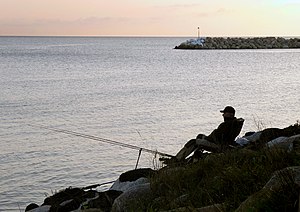
Recreational fishing, also called sport fishing, is fishing for pleasure or competition. It can be contrasted with commercial fishing, which is professional fishing for profit; or subsistence fishing, which is fishing for survival.
The most common form of recreational fishing is angling, which is done with a rig of rod, reel, line, hooks and any one of a wide range of baits, collectively referred to as terminal tackles. Other devices are also used to affect or complement the presentation of the bait to the targeted fish, such as weights, floats, swivels and method feeders. Lures are frequently used in place of fresh bait when fishing for predatory fishes. Some hobbyists hand-make tackles themselves, including plastic lures and artificial flies.
Other forms of recreational fishing include spearfishing, which is done with a speargun or harpoon while diving; and bowfishing, with is done from above the water with archery equipments such as a compound bow or a crossbow.
Big-game fishing is conducted from yachts to catch large open-water fish species such as tunas, billfishes (e.g. marlins) and sharks. Noodling and trout tickling are also recreational activities.

Lift nets in Cà Mau, Vietnam

Fly fishing in a river
Commercial sector[]

Commercial fishing is the activity of catching fish and other seafood for commercial profit, mostly from wild fisheries. It provides a large quantity of food to many countries around the earth, but those who practice it as an industry must often pursue fish far into the ocean under adverse conditions. Large-scale commercial fishing is also known as industrial fishing.
The major fishing industries are not only owned by major corporations but by small families as well.[9] In order to adapt to declining fish populations and increased demand, many commercial fishing operations have reduced the sustainability of their harvest by fishing further down the food chain. This raises concern for fishery managers and researchers, who highlight how further they say that for those reasons, the sustainability of the marine ecosystems could be in danger of collapsing.[9]
Commercial fishermen harvest a wide variety of animals. However, a very small number of species support the majority of the world's fisheries of these species are herring, cod, anchovy, tuna, flounder, mullet, squid, shrimp, salmon, crab, lobster, oyster and scallops. All except these last four provided a worldwide catch of well over a million tonnes in 1999, with herring and sardines together providing a catch of over 22 million metric tons in 1999. Many other species are fished in smaller numbers.
In 2016, of the 171 million tonnes of fish caught, about 88 percent or over 151 million tonnes were utilized for direct human consumption. This share has increased significantly in recent decades, as it was 67 percent in the 1960s.[10] In 2016, the greatest part of the 12 percent used for non-food purposes (about 20 million tonnes) was reduced to fishmeal and fish oil (74 percent or 15 million tonnes), while the rest (5 million tonnes) was largely utilized as material for direct feeding in aquaculture and raising of livestock and fur animals, in culture (e.g. fry, fingerlings or small adults for ongrowing), as bait, in pharmaceutical uses and for ornamental purposes.[10]World production[]
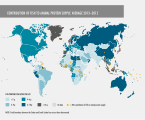
Contribution of fish to animal protein supply, average 2013–2015

World capture fisheries and aquaculture production 1950–2015
Fish are harvested by commercial fishing and aquaculture.
The world harvest increased over the 20th century and, by 1986, had stabilized around 85–95 million metric tons (94×106–105×106 short tons) per year.[11] According to the Food and Agriculture Organization (FAO), the world harvest in 2005 consisted of 93.3 million metric tons (102.8×106 short tons) captured by commercial fishing in wild fisheries, plus 48.1 million metric tons (53.0×106 short tons) produced by fish farms. In addition, 1.3 million metric tons (1.4×106 short tons) of aquatic plants (seaweed etc.) were captured in wild fisheries and 14.8 million metric tons (16.3×106 short tons) were produced by aquaculture.[12] The number of individual fish caught in the wild has been estimated at 0.97–2.7 trillion per year (not counting fish farms or marine invertebrates).[13]
Following is a table of the 2011 world fishing industry harvest in tonnes (metric tons) by capture and by aquaculture.[12]
| Capture (ton) | Aquaculture (ton) | Total (ton) | |
|---|---|---|---|
| Total | 94,574,113 | 83,729,313 | 178,303,426 |
| Aquatic plant | 1,085,143 | 20,975,361 | 22,060,504 |
| Aquatic animal | 93,488,970 | 62,753,952 | 156,202,922 |
Related industries[]
Once fish is caught, especially in commercial sectors, bringing the fish to consumers require a complex series of related industries.
Fish farming[]
Aquaculture is the cultivation of aquatic organisms. Unlike fishing, aquaculture, also known as aquafarming, is the cultivation of aquatic populations under controlled conditions.[14] Mariculture refers to aquaculture practiced in marine environments. Particular kinds of aquaculture include algaculture (the production of kelp/seaweed and other algae); fish farming; shrimp farming, shellfish farming, and the growing of cultured pearls.
Fish farming involves raising fish commercially in tanks or enclosed pools, usually for food. Fish species raised by fish farms include carp, salmon, tilapia, catfish and cod. Increasing demands on wild fisheries by commercial fishing operations have caused widespread overfishing. Fish farming offers an alternative solution to the increasing market demand for fish and fish protein.
Fish processing[]
Fish processing is the processing of fish delivered by commercial fisheries and fish farms. The larger fish processing companies have their own fishing fleets and independent fisheries. The products of the industry are usually sold wholesale to grocery chains or to intermediaries.
Fish processing can be subdivided into two categories: fish handling (the initial processing of raw fish) and fish products manufacturing. Aspects of fish processing occur on fishing vessels, fish processing vessels, and at fish processing plants.
Another natural subdivision is into primary processing involved in the filleting and freezing of fresh fish for onward distribution to fresh fish retail and catering outlets, and the secondary processing that produces chilled, frozen and canned products for the retail and catering trades.[15]
Fish products[]
Fisheries are estimated to currently provide 16% of the world population's protein. The flesh of many fish are primarily valued as a source of food; there are many edible species of fish. Other marine life taken as food includes shellfish, crustaceans, sea cucumber, jellyfish and roe.
Fish and other marine life can also be used for many other uses: pearls and mother-of-pearl, sharkskin and rayskin. Sea horses, star fish, sea urchins and sea cucumber are used in traditional Chinese medicine. Tyrian purple is a pigment made from marine snails, and sepia is a pigment made from the inky secretions of cuttlefish. Fish glue has long been valued for its use in all manner of products. Isinglass is used for the clarification of wine and beer. Fish emulsion is a fertilizer emulsion that is produced from the fluid remains of fish processed for fish oil and fish meal.
In the industry the term seafood products is often used instead of fish products.
Fish marketing[]
Fish markets are marketplace used for the trade in and sale of fish and other seafood. They can be dedicated to wholesale trade between fishermen and fish merchants, or to the sale of seafood to individual consumers, or to both. Retail fish markets, a type of wet market, often sell street food as well.
Most shrimp are sold frozen and are marketed in different categories.[16] The live food fish trade is a global system that links fishing communities with markets.
Environmental impact[]
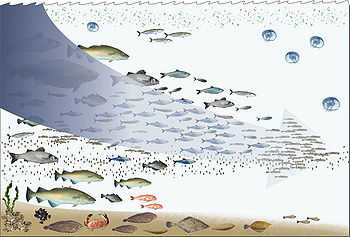
The environmental impact of fishing includes issues such as the availability of fish, overfishing, fisheries, and fisheries management; as well as the impact of industrial fishing on other elements of the environment, such as by-catch. These issues are part of marine conservation, and are addressed in fisheries science programs. According to a 2019 FAO report, global production of fish, crustaceans, molluscs and other aquatic animals has continued to grow and reached 172.6 million tonnes in 2017, with an increase of 4.1 percent compared with 2016.[17] There is a growing gap between the supply of fish and demand, due in part to world population growth.[18]
The journal Science published a four-year study in November 2006, which predicted that, at prevailing trends, the world would run out of wild-caught seafood in 2048. The scientists stated that the decline was a result of overfishing, pollution and other environmental factors that were reducing the population of fisheries at the same time as their ecosystems were being annihilated. Many countries, such as Tonga, the United States, Australia and Bahamas, and international management bodies have taken steps to appropriately manage marine resources.[19][20]
Reefs are also being destroyed by overfishing because of the huge nets that are dragged along the ocean floor while trawling. Many corals are being destroyed and as a consequence, the ecological niche of many species is at stake.International disputes[]
The ocean covers 71% of the earth's surface and 80% of the value of exploited are attributed to the fishing industry. The fishing industry has provoked various international disputes as wild fish capture rose to a peak about the end of the 20th century, and has since started a gradual decline.[21] Iceland, Japan, and Portugal are the greatest consumers of seafood per capita in the world.[citation needed]
Disputes in the Americas[]
Chile and Peru are countries with high fish consumption, and therefore had troubles regarding their fish industries. In 1947, Chile and Peru first adopted the 200 nautical mile standard as their exclusive economic zone (EEZ), and in 1982, the UN formally adopted this term. In the 2000s, Chile and Peru suffered a serious fish crisis because of excessive fishing and lack of proper regulations, and now political power play in the area is rekindled[clarification needed].[22] From the late 1950s, offshore bottom trawlers began exploiting the deeper part, leading to a large catch increase and a strong decline in the underlying biomass. The stock collapsed to extremely low levels in the early 1990s and this is a well-known example of non-excludable, non-rivalrous public good in economics, causing free-rider problems.[citation needed]
Following the collapse of the Atlantic northwest cod fishery in 1992, a dispute arose between Canada and the European Union over the right to fish Greenland halibut (also known as turbot) just outside of Canada's exclusive economic zone in the Grand Banks of Newfoundland. The dispute became known as the Turbot War.[23][24] On 9 March 1995, in response to observations of foreign vessels fishing illegally in Canadian waters and using illegal equipment outside of Canada's EEZ, Canadian officials boarded and seized the Spanish trawler Estai in international waters on the Grand Banks.[25] Throughout March, the Spanish Navy deployed patrol ships to protect fishing boats in the area,[26] and Canadian forces were authorized to open fire on any Spanish vessel showing its guns.[citation needed] Canada and the European Union reached a settlement on 15 April which led to significant reforms in international fishing agreements.[27]
Disputes in Europe[]
Iceland is one of the largest consumers in the world and in 1972, a dispute occurred between UK and Iceland because of Iceland's announcement of an Exclusive Economic Zone (EEZ) to reduce overfishing. This dispute is called the Cod Wars, direct confrontations between Icelandic patrol vessels and British warships.[citation needed]
Nowadays in Europe in general, countries are searching for a way to recover their fishing industries. Overfishing of EU fisheries is costing 3.2 billion euros a year and 100,000 jobs according to a report. So Europe is constantly looking for some collective actions that could be taken to prevent overfishing.[28]
Disputes in Asia[]
Japan, China and Korea are some of the greatest consumers of fish, and have some disputes over Exclusive Economic Zone.[29] In 2011, due to a serious earthquake, the nuclear power facility in Fukushima was damaged. Ever since, huge amount of contaminated water leaked and is entering the oceans. Tokyo Electric Power Company (Tepco) admitted that around 300 tonnes of highly radioactive water had leaked from a storage tank on the site. In the Kuroshio Current, the sea near Fukushima, about 11 countries catch fish. Not only the surrounding countries such as Japan, Korea and China, but also the countries like Ukraine, Spain and Russia have boats in the Kuroshio Current. In September 2013, South Korea banned all fish imports from eight Japanese prefectures, due to the radioactive water leaks from the Fukushima nuclear plant.[28]
By country[]
See also[]
References[]
- ^ World Food and Agriculture – Statistical Yearbook 2020. Rome: FAO. 2020. ISBN 978-92-5-133394-5.
- ^ Jump up to: a b FAO Fisheries Section: Glossary: Fishing industry. Retrieved 28 May 2008.
- ^ Fisheries and Aquaculture in our Changing Climate[permanent dead link] Policy brief of the FAO for the UNFCCC COP-15 in Copenhagen, December 2009.
- ^ United Nations (2017) Resolution adopted by the General Assembly on 6 July 2017, Work of the Statistical Commission pertaining to the 2030 Agenda for Sustainable Development (A/RES/71/313)
- ^ "Industry". Fisheries Research and Development Corporation. Archived from the original on 14 June 2009. Retrieved 28 December 2020.
- ^ Garcia, S.M. (2009). "Glossary". In Cochrane, K.; Garcia, S.M. (eds.). A fishery managers handbook. FAO and Wiley-Blackwell. pp. 473–505.
- ^ Ozyurt, Refik (2013). "Socio-economic status of small scale / artisanal fisheries in Middle and Eastern Black Sea Regions". Turkish National Thesis Center (in Turkish).
- ^ "Sustainable development goals".
- ^ Jump up to: a b Endter-Wada J, Keenan S (2005). "Adaptations by Long-Term Commercial Fishing Families in the California Bight: Coping with Changing Coastal Ecological and Social Systems". Human Organization. 64 (3): 225–237. doi:10.17730/humo.64.3.0c2uc20ct6mgdmjf.
- ^ Jump up to: a b In brief, The State of World Fisheries and Aquaculture, 2018 (PDF). FAO. 2018.
- ^ Larsen, Janet (16 July 2003). "Other Fish in the Sea, But For How Long?". Earth Policy Institute. Retrieved 3 June 2020.
- ^ Jump up to: a b "FAO Fisheries & Aquaculture - Home". Retrieved 30 January 2016.
- ^ A Mood and P Brooke (July 2010). Estimating the Number of Fish Caught in Global Fishing Each Year. FishCount.org.uk.
- ^ "Answers - The Most Trusted Place for Answering Life's Questions". Answers.com. Retrieved 30 January 2016.
- ^ Smith, David (March 2004). "Inquiry into The Future of the Scottish Fishing Industry" (PDF). Royal Society of Edinburgh. Archived from the original (PDF) on 1 July 2007. Retrieved 28 December 2020.
- ^ Shang, Yung C.; Leung, Pingsun; Ling, Bith-Hong (1998). "Comparative economics of shrimp farming in Asia". Aquaculture. 164: 183–200. doi:10.1016/s0044-8486(98)00186-0.
- ^ Food and Agriculture Organization of the United Nations (FAO) (2019). "Fishery and Aquaculture Statistics 2017" (PDF). Archived (PDF) from the original on 26 October 2019.
- ^ "Global population growth, wild fish stocks, and the future of aquaculture | Shark Research & Conservation Program (SRC) | University of Miami". sharkresearch.rsmas.miami.edu. Retrieved 2 April 2018.
- ^ Worm, Boris; et al. (3 November 2006). "Impacts of Biodiversity Loss on Ocean Ecosystem Services". Science. 314 (5800): 787–790. Bibcode:2006Sci...314..787W. doi:10.1126/science.1132294. PMID 17082450. S2CID 37235806.
- ^ Juliet Eilperin (2 November 2006). "Seafood Population Depleted by 2048, Study Finds". The Washington Post.
- ^ Millennium Ecosystem Assessment
- ^ "In Mackerel's Plunder, Hints of Epic Fish Collapse". International Herald Tribune. 25 January 2012. Retrieved 30 January 2016 – via The New York Times.
- ^ Anderson, Lisa (19 March 1995). "Depleted fish stocks spark Canada's turbot war with Spain". Chicago Tribune. Retrieved 28 December 2020.
- ^ "Court backs Canada's seizure of trawler during 'turbot war'". CBC News. 27 July 2005. Retrieved 28 December 2020.
- ^ Swardson, Anne (10 March 1995). "Canada Fires Warning Shots; Seizes Spanish Fishing Boat". The Washington Post. Retrieved 28 December 2020.
- ^ Tremlett, Giles (23 March 1995). "Spanish trawler Estai reaches port". United Press International. Retrieved 28 December 2020.
- ^ Damanaki, Maria (6 September 2010). "Answer to Question No E-4682/10". European Parliament. Retrieved 28 December 2020.
- ^ Jump up to: a b "Overfishing 'costs EU £2.7bn each year'". BBC News. Retrieved 30 January 2016.
- ^ Urbina, Ian. "The deadly secret of China's invisible armada". www.nbcnews.com. NBC News. Retrieved 11 August 2020
External links[]
- Fishing industry
- Industries (economics)






